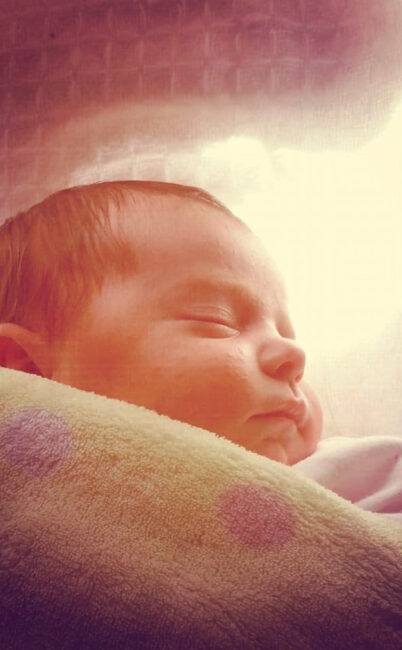The following image was submitted to the NZ Paranormal Research discussion group. It shows a sleeping child with a light anomaly in the upper right quadrant. The image, having been uploaded to Facebook, has been stripped of all useful meta-data, so we cannot make any determination of the camera settings at the time the photograph was taken. This means we only have the visual data from the image to analyse.

Isolating the anomaly
Adjusting the contrast of the image, we can get a better view of the shape of the light anomaly to look for identifiable features. A light cross-hatching can be seen, which is the result of image compression when the photograph was saved to JPG or a similar compressed format.

With the removal of the “haze” we can see a right angled hook-like section above the child’s forehead. We can also see that the light anomaly has two slightly different shades, becoming more evident as we adjust the contrast futher.

Initial hypothesis
Lacking the photograph meta-data, we cannot be certain, but due to the age of the image (taken in 2014) and the resolution, it is less to have been taken with a camera using automatic High Dynamic Range (HDR), and yet the there is a wide range between the light and shadows in the image. Unless the image was adjusted using photo editing software, we could assume the camera utilised a more common Slow Sync Flash setting, where the camera delays firing the flash and exposes the photograph longer to get more detail in the shadows while still illuminating the highlights.
The Slow Sync Flash setting is often enabled when cameras are in Auto mode, and a photographer unfamiliar with this setting may not realise the camera is taking a longer exposure photograph, and may move the camera before the image capture has been completed. This is a common cause of light anomalies in photographs as you end up with a kind of “double-exposure” with the brightly illuminated areas from the flash overlapping or shifting in frame.
If we take this hypothesis to be true, we should look at the over-exposed areas, such as this light anomaly, and see if there are any features which are replicated elsewhere in the photograph.
Overlapping the image
Examining the light anomaly, I noticed the hook-like section mentioned above roughly corresponds with light and shadow areas of the child’s nose. The lighter shade within the anomaly also roughly follows the shape of the child’s right cheek. The size and angle is different, however if the camera was moved closer and rotated as the image was exposed, this would account for the change in position.
Here we have resized the contrast-enhanced image and rotated it by 45 degrees.

Removing the dark areas to left only the enhanced shape of the anomaly itself, we can overlay this next to the child’s face in the image and observe the similar shape of the light and shadows to the features of the child’s nose and cheek.

The match is not an exact one, however there may have been a three-dimensional component to the movement of the camera as the image was exposed, which could account for the slight difference in angle.
Conclusion
While we do not have enough information to be certain, the effect of Slow Sync Flash and the resulting light anomalies are effects which are often misinterpreted as paranormal evidence in photographs. As is often the case when examining potential evidence of the paranormal the old saying “When you hear hoof-beats, think horses, not zebras.” We can only consider something to be paranormal when all other “normal” possibilities have been eliminated first.
For more information on these types of photographic anomalies, check out the following articles from the paranormal community:
http://www.assap.ac.uk/newsite/articles/Paranormal%20photos.html
https://livinglifeinfullspectrum.com.au/blog/is-it-paranormal-or-is-it-just-slow-shutter-speed/
http://nyackparanormal.com/LibraryArticlesStreakedLight.htm

